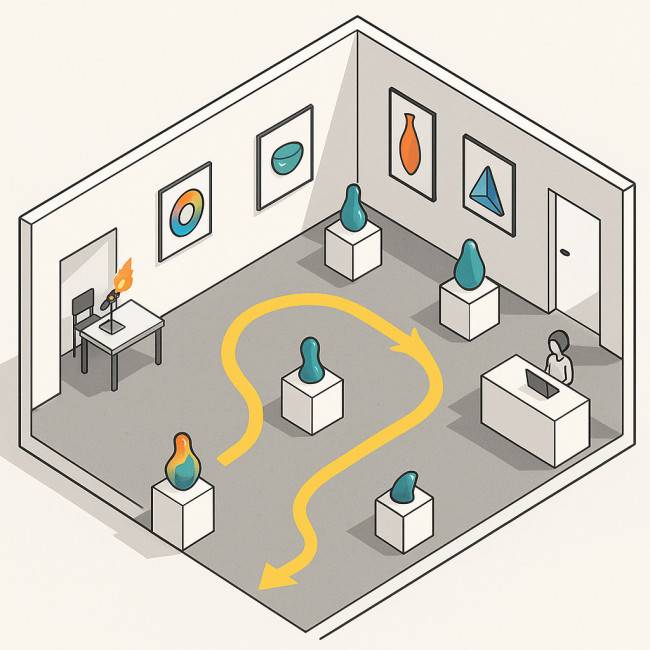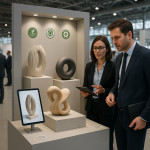Glass artist pop-up exhibits: logistics checklist for seamless visitor flow
Launching glass artist pop-up exhibits is exciting—yet one cracked vessel or blocked aisle can sink your reputation. This guide delivers a step-by-step logistics checklist so you welcome every visitor smoothly, protect fragile works, and leave venue managers eager for an encore.
Why logistics can make—or break—glass artist pop-up exhibits
Unlike static gallery shows, glass artist pop-up exhibits compress set-up, sales and teardown into a few adrenaline-filled hours. Tight timing, delicate pieces and unpredictable crowd surges demand flawless visitor flow. With clear checkpoints you reduce breakage risk, raise dwell time and gather the data that secures bigger venues through event-focused craft directories.
Pre-event site survey: map every centimetre
Key measurements to capture
- Door width and lift capacity for crated sculptures
- Emergency exit routes—keep 1.2 m minimum width clear
- Ambient light levels (lux) to avoid glare on transparent pieces
- Floor load rating; thick glass installations can exceed 400 kg/m²
Snap photos, then overlay measurement notes in a digital floor planner. This becomes the backbone of your visitor flow diagram and packing order.
Inventory & risk assessment before packing
List every artwork with dimensions, weight, insurance value and handling notes. Tag crates so crew identify the unpack sequence fast. For shipping specs that prevent on-route damage, review professional glass packaging guidelines.
Designing visitor flow for glass artist pop-up exhibits

Visualizing the circulation on paper is useful, yet nothing beats an illustrated floor plan that lets your crew see distances and choke-points at a glance. Think of this diagram as the rehearsal before the physical dress rehearsal: it communicates how a stroller moves past a pedestal, where a collector can pause without blocking the queue, and how handlers can slip through a back corridor when a fragile piece needs cleaning. By sharing the plan in your Slack channel and printing A3 copies for venue walls, you transform abstract flow theory into concrete instructions every stakeholder can reference in real time.
Four circulation zones
- Entry beacon – one hero piece visible from outside draws walk-ins.
- Meander path – S-shaped route slows pace and reveals angles.
- Interactive demo corner – live torchwork keeps queues moving while guests wait for checkout.
- Exit & pick-up – separate door for wrapped sales prevents bottlenecks.
Source : Smithsonian Visitor Studies
The chart shows that queue length grows exponentially when average dwell time tops 35 minutes. Curate under 15 pieces or widen aisles if you expect 125+ visitors per hour.
Staffing matrix: assign clear roles
| Role | Main duties | Ideal ratio |
|---|---|---|
| Greeter | Count visitors, give handling rules | 1 per 80 guests/hour |
| Artwork handler | Gloved repositioning, cleaning | 1 per 20 pieces |
| Sales lead | Process payments & wraps | 1 per checkout station |
| Demo artist | Live lampwork safety | Optional |
Transport & on-site handling checklist
- Load heaviest crates last for first-off placement.
- Use wheel-able dollies rated 200 kg and corner straps to avoid glass shift.
- Stage unpacking in a fenced zone; no visitor entry until waste cleared.
When showcasing scarce series, align packaging with limited edition run strategy so buyers receive numbered certificates before leaving.
Sustainability & safety
Modern pop-ups thrive when eco-credentials match aesthetics. Source recycled cushioning and set up a glass off-cut recycle bin. Verify air change rates if flame demos run indoors; workshop ventilation guidelines list 10 ACH as a safe minimum.
Day-of timeline: your hour-by-hour logistics plan
| Time | Action | Responsibility |
|---|---|---|
| 08:00 | Vehicle unload sequence | Logistics lead |
| 09:30 | Lighting and label check | Curator |
| 10:15 | Soft open for press | Greeter |
| 11:00 | Main doors open | All staff |
| 15:00 | Mid-show inventory tally | Sales lead |
| 18:00 | Last entry + wrap-up sales | Greeter/Sales |
| 19:00 | Teardown begins | Handlers |
Glass artist pop-up exhibits post-event metrics
Track conversion rate (pieces sold ÷ visitors), average ticket size and dwell time. Feed numbers into your next venue pitch deck to prove ROI. Some artists increase post-show online orders by embedding behind-the-scenes clips into their follow-up email—mirroring tactics in process-driven case studies.
Quick quiz: test your logistics savvy
FAQ
- How many pieces should I display in a 30 m² pop-up?
- Aim for 10–12 key works so visitors maintain a comfortable 35 minute dwell time without clogging aisles.
- Can I reuse crates for multiple glass artist pop-up exhibits?
- Yes—if crates carry ISPM-15 stamps, remain crack-free and foam cut-outs still hug the glass snugly.
- What POS system handles offline payments best?
- Choose terminals with 4G fallback and battery life over eight hours; Square and SumUp rank high among roaming exhibitors.
- Do I need extra insurance for lampworking demos?
- Most venues require a rider covering open flames. Speak with your broker at least two weeks prior.
- How soon should I email attendees after the event?
- Within 24 hours while excitement is fresh. Include a limited-time online shop link and a thank-you discount code.
Ready to plan your next pop-up?
Download the printable checklist, block your survey visit, and secure crates early. A smooth visitor journey today fuels glowing reviews and bigger stages tomorrow. Let's make your glass artist pop-up exhibits unforgettable.











